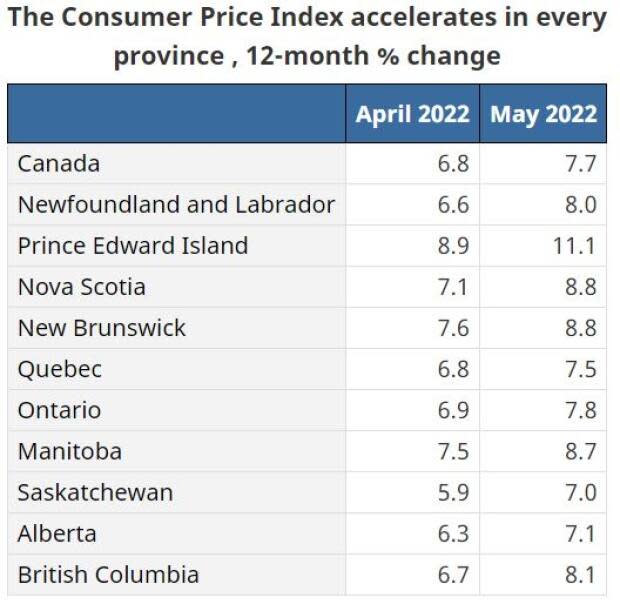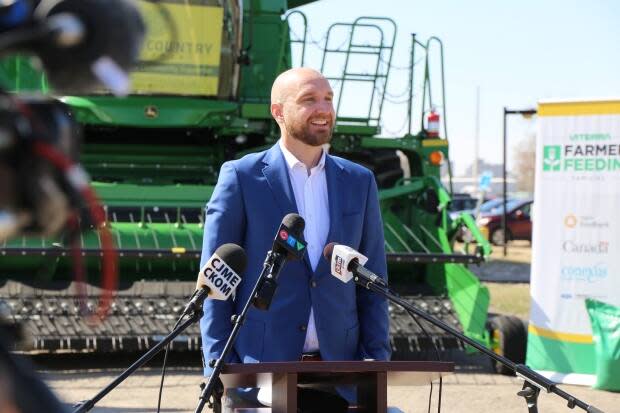Sask. food banks see spike in clients, drop in donors as inflation hits 40-year high
![Food banks in the province are 'seeing clients returning who haven't had to use this for a few years, but now they're having to come back,' said Food Banks of Saskatchewan executive director Michael Kincade. '[It's] not that their incomes changed, but the cost of living.' (Evan Mitsui/CBC - image credit)](https://s.yimg.com/ny/api/res/1.2/x9zKh4doNwIQ6XKi2HgDPg--/YXBwaWQ9aGlnaGxhbmRlcjt3PTEyNDI7aD05MzI-/https://media.zenfs.com/en/cbc.ca/018825bd7c6a264498ad92878e4b7e6b)
While Saskatchewan has the lowest inflation rate in Canada, residents are still feeling the negative financial effects of skyrocketing inflation, and the province's food banks are among those hardest hit.
"All of our food banks, from rural to urban, are all in a crunch right now, and we've been slowly seeing this get worse and worse," said Michael Kincade, who oversees 36 food banks across the province as the executive director for Food Banks of Saskatchewan.
"It's not just affecting the poorest of the poor. It's affecting everybody who was … just making it before. Now we're seeing less donors, less donations coming in."
Canada's year-over-year inflation rate rose by 7.7 per cent in May — its largest increase in almost 40 years, as the price of just about everything continues to climb. In Saskatchewan, the Consumer Price Index increased by seven per cent between May 2021 and May 2022, according to Statistics Canada.
Food prices were a major factor to the spike, Statistics Canada reported Wednesday, with grocery bills increasing by 9.7 per cent over the past year.
Food banks are "seeing clients returning who haven't had to use this for a few years, but now they're having to come back," said Kindcade. "[It's] not that their incomes changed, but the cost of living."
An uptick in the price of gasoline was also a major factor in the inflation rate, Statistics Canada said. Gas prices rose by 12 per cent in the month of May alone, and are up by 48 per cent compared to where they were a year ago.

Kincade said many residents who have to drive for work in rural areas of Saskatchewan, where public transit isn't available, are struggling.
"So now … they rob from their food budget, because they have to. They have to still pay for the house, the bills. They have to put gas in their vehicle so they can work."
Meanwhile, donations to food banks are also at a low, Kincade said.
"Every one of our 36 food banks is struggling and begging for food at the moment. So that puts a stress on everyone."
Meeting the demand
The rising food prices are particularly affecting good-quality food like proteins, meats and fresh produce, and that's what food banks are always in desperate need of, Kincade said.
"It was tough to get before. It's even tougher to get now."
The majority of people food banks typically see are single-income families, single people, children, senior citizens and people with disabilities, he said. But now, they are also starting to see an influx of young people.
They're also not seeing the amount in food shares from the Food Banks Canada network that they normally do, Kincade said.
"We're just not seeing them because of the transportation costs. And even if there is something available, it's very difficult to get it delivered from Ontario or other parts of Canada to here, because there's a shortage and the costs are horrendous."

Inflation is definitely affecting the Regina Food Bank's ability to meet the needs of people coming to it for help, said CEO John Bailey, as well as the number of people turning to it for support.
"While [food prices] are not spiking the same way gas is right now, that sort of pressure has been put on families and individuals for most of 2022."
How long will high prices last?
Like Kincade, Bailey said Regina's food bank is seeing fewer donors and more clients.
Pre-pandemic, the food bank averaged about 80,000 points of service — or individual visits — per year, Bailey said.
Between 2020 and 2021, the food bank averaged 110,000, and that number rose to an average of 120,00 in 2021-22. The food bank is projecting more than 130,000 individual visits for the current cycle, Bailey said.
There are now concerns about the food bank's physical capacity to hold all the food needed to meet the demand, he said.
The Regina Food Bank is preparing itself to deal with further inflation spikes, said Bailey.
"We're months and months away from it going down. That's going to push more people who are sort of on the verge of being food insecure to being insecure, just because of the sustained cost of living."
Kincade also believes inflation will continue.
"It's going to be a while. I don't think we've peaked yet. It's going to be a tough road ahead. Our biggest challenge is going to be getting food, getting donations, but then getting it here as well. The transportation costs are killing us."
Saskatchewan food banks need government funding to buy food, funding to offset the cost of transportation, and gas prices to go down, said Kincade.
"We've got to see some sort of relief on the horizon."

